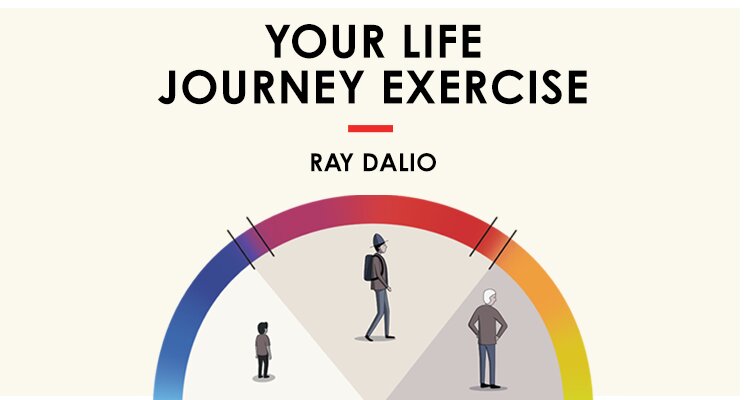This exercise is intended to help you put your life and the lives of the people you care about in perspective and to plan for the future to help you get the life you want.
This perspective has helped me and many people I have shared it with. I hope it will help you. If you’d like to experience an interactive version of the exercise, you can in the free Principles in Action app.

As you know, I have found that most everything happens over and over again for pretty much the same reasons, so in order to understand anything, it pays to understand how a typical case unfolds and observe the cause-effect relationships that make it unfold that way. Then, with that typical case in mind, one can look at differences between individual cases and the typical case to understand the reasons for the differences.
In this exercise, I am going to ask you to look at both the typical life arc and your own life arc and reflect on them.
This exercise will help you imagine what probably will come at you, plan for it, and deal with it when it comes.
Not all life arcs are the same, and no arc is better in any way than another—they’re each their own unique journey, reflecting the circumstances faced by and decisions of the person travelling the arc.
At the same time, most arcs are pretty similar to each other and vary from each other for relatively few reasons. For example, the archetypical life lasts about 80 years and evolves in three very different phases, with two roughly 5- to 10-year transition phases between them.
Even if your life arc bears little resemblance to the typical one, my hope is that you’ll find value in reflecting on your journey.
In the first phase, you learn and are dependent on others. That is when you are in school and under your parents’ care.
In the second phase, you work and others are dependent on you. That is when you are trying to be successful at work and successful with your family at the same time, so you are facing a challenge with work-life balance.
In the third phase, you are free of all that so you can savor life without obligations and are free to die. In the transition from the second to the third phase, your natural inclinations and contributions come from passing along the gifts you can give that will help others succeed without you. (This third phase is the phase I’m now in, which is motivating my actions.)
While you can’t change the phase you are in, you can know where you and the people you care about are and where you all are headed, and you can plan for it and adapt to it well.
The chart below shows the typical life arc. It is chronological from birth to death.
To put where you are in perspective, estimate about where you are on that arc. You don’t have to be precise because life isn’t precise, and you don’t have to look at the individual milestones shown (though you can if you like) to identify your approximate location on the life arc.
From where you are on the arc, I will ask you to look back on a checklist of milestones to see which ones you’ve passed to reach where you are. Doing that will help you see the track you have been on, which will also help to point you to where you are headed.
Later I will also ask you to look at the milestones that are likely to be ahead for you and the people you care deeply about so you can imagine where you and they will be in 10 years and what will happen on the way there.
I suggest that you get a few pieces of note paper and a pen or pencil, copy the basic arc without all the milestones or print the arc as shown below, and put a tick where you are with “me” next to it. (You can also draw the arc if you don’t have a printer.) Also, put ticks and initials of the people who matter most to you on the chart to represent where they are.
Looking through these phases, note how the descriptions of what’s happening to the typical person match up with your own experiences, especially at the critical junctures. The choices you make at these junctures have big implications on the life that you will have.
As you will see, while the basic life arc is pretty much the same for most of us, the paths we take along the way affect the type of journey we have.
Phase 1
In the first phase, you are born with certain natural inclinations and into different circumstances. While there are differences, in this phase everyone is dependent on those who are guiding them (probably a parent or two) and will go through four sub phases which correspond to pre-school, elementary, middle, and high school.
Within each of these sub-phases the brain is poised to learn different things. For example in the pre-school years, the baby and then the toddler gets varying degrees of security, curiosity, and determination; in the elementary years, the young child is more receptive to learning social interactions and languages; in the middle school years, puberty shifts one’s brain function a lot, so helping through that transition is important; and in the post-puberty high school years, one’s brain is better suited for learning social, emotional, and analytical skills.
While I won’t delve into early childhood development because I’m no expert and my goal here is just to deal with the big arc, I will point out that all experts agree that how the brain works and what it is ready to learn changes a lot at puberty (around ages 9 to 11). This is the age when the child is turning into a young adult and is much more capable of, and inclined to, think for him/herself. At this stage, the brain is naturally motivated to self-discover and self-direct which can lead to constructive or destructive behaviors.
One common feature of the most successful independent thinkers I have gotten to know is that, starting around age 12, they all developed their own passions for, and independent learnings about, subject areas that they pursued through most of their lives and became superb at.
I will call this 1) the successful self-directed path. At the risk of over-simplifying, those that didn’t go down that path either went down the 2) following-instructions-of-others path or the 3) seeking independence and stimulation from unhealthy pursuits and substances path. Often these three paths overlap, so they’re not clear-cut, and they can change but they don’t change much because these years are few. They set the stage for what comes next, so which path is chosen plays an important role in influencing the future.
If you’re in this first phase of life, please think about which path you want to be on. If you are past this phase, think about which path you went down and how it influenced you, and if you are directing a child in this phase, please think which way you want to direct them. I suggest you note on that piece of paper whatever your thoughts are about this to refer to later.
One of the great struggles in this first phase in life is how much to be guided to follow instructions relative to how much to be allowed to think and learn for oneself. Most of this whole first phase (until one graduates from school) consists of being guided to behave in ways that those guiding you would like to have you behave and to process information in the way one is taught to process information.
There is not much opportunity to self-discover what one wants and to figure out how to get it on one’s own, yet doing that is the most important skill to have in order to get what one wants out of life. Both receiving the guidance of others well and learning to think for yourself are important to your development during this phase, particularly in the post-puberty years.
The high school years are typically among the most fun and most challenging because hormones are kicking in, there is a greater amount of freedom, there is an instinctual desire for greater independence from those who are overseeing you, and there are pressures to get well-positioned for what comes next (e.g. to get good grades in high school to get into a good college).
These things typically happen most intensely in the junior year of high school. During these high school years there’s not much room to make important decisions for yourself because you will most likely either be on a track or neglected. If you are on a track, you are shooting for what comes next, such as getting into a good college.
As you work through this critical phase of deciding what you want, please remember that 1) while you might know what excites you and what doesn’t excite you, you don’t know hardly anything yet about what direction in life will be best for you, 2) it’s best to maximize your options by maximizing your desirability to those who will chose or reject you, and 3) it’s wise to pursue a path that both excites you and gives you the greatest ability to have the widest range of choices. A great education can be a source of joy and a power. At the same time, feeling what you are pulled toward and exploring for yourself how to learn about it and acquire skills with it is comparably important.
If you are responsible for guiding those in the first phase (e.g. parents who are in their second phase), you should consider how you balance guiding them versus allowing independent thinking. Try to do both and do them well. This high school phase can be a challenging one for your parent-child relationship because the trade-offs of different choices are difficult to weigh and there can be disagreements over independence.
Beyond these high school years you will either 1) go to college or 2) go straight into the second phase by going to work. Which path you go down (as well as which college or work you go into) will put you on different paths of this life journey. This decision is often one people don’t get to make for themselves because it will be dictated by the circumstances that led them to this point in life.
If you go to college, you typically will have much more freedom and fun with friends and will experience greater intellectual stimulation. Still you might struggle to figure out your preferences and how to behave, and you might wrestle with insecurities and/or your arrogance because that is typical at that stage (it takes years to get the balance right). During these college years you probably will still be more directed than free-thinking because most of your life is pretty much laid out for you. The only really big decision you will have to make is the major you choose. Working your first job in which you do something that people pay you for gives you real world experiences that provide important learning for later life.
The next phase will begin when you end your school education and begin to work.
Please take a moment now to note how many of the 14 milestones above you have passed. Note that percentage as the “percent of typical first stage of life arc.” Also write down on your note paper which paths you went down—ie, self-directed on productive pursuits, self-directed on unproductive ones, following the path laid out by others.
Now reflect. If you are early in the first phase, note milestones that you probably will encounter ahead of you which will shape you and your direction in life, and think about the choices you want to make to have the best life for you.
If you are through your first phase, you probably will have done most of these things. Note to what extent that’s true because it will help you see how closely your path has followed the typical path. If you are still in this phase, note where you are and look at the things that are likely to come at you and those you care about over the next 10 years.
Phase 2
The second phase is more opposite than similar to the first phase. When you go from the first to second phase, you will step off the track that you were guided on and become free to make your own choices which are wide ranging.
You can live anywhere in the world you want, work any job you can get, and be with whoever you want to be with. In other words, you can do pretty much anything you want if you are clever and capable enough to make it happen.
At this first part of this second phase some people 1) experiment and explore, while others 2) stay on the track they were on to take the best job they can find in the career area they planned to pursue. I personally think that experimenting and exploring some at this stage and then gradually honing in on what you want to focus on is the best combination.
Remember that this is a totally new phase that you are a novice in, so the key will be to be open-minded in your learning about how to handle it and to discover principles for dealing with it well.
I will break this second phase down into the early, mid, and late parts.
The early part, which happens in one’s mid-20s to early 30s, is typically one of the happiest and most care-free periods in life. During it, you will probably have fun with friends and favorite activities, have romances, and will find the partner you intend to spend your life with. In this phase your career path will start to harden. This is when I hope you will pay attention to my principle “Make your work and passion the same thing and do it with people you want to be with”—and don’t overlook the money part because money gives security, freedom, and other good things to you and those you are responsible for taking care of.
As you progress into the middle part of this second phase (typically in the 30-40 age range), you will take on more responsibilities at work and in your love life, and you probably will find a spouse and start your own family. When you have a child, that will be a marker that you are probably a bit more than 1/3 through your life. It also will probably coincide with your parents entering their third and final phase of life. This is when one’s work-life balance typically becomes increasingly challenging.
The late and last part of this second phase period typically takes place around ages 40 to 55 and is reported to be one of the least happy phases of life on average. Being successful at work and in one’s private life is typically more difficult than you imagined it would be.
During this phase one typically worries most about one’s children, one’s job, one’s parents, and whether one is achieving the life one dreamed of. It’s also when some of the illusions can be lost and when divorces are highest. During this phase, loving one’s work and one’s relationships is especially valuable because that is what keeps one excited and fulfilled through what could otherwise be a challenging time.
Most people in the 55-65 period are ending this second phase and beginning to move to the third phase when they approach the end of their careers and the end of raising their children. Sometime in the period is when the 5-10 year transition into the third and last phase starts.
Once again I’d like you to view the description of this phase from where you are in your life arc.
If you have this phase ahead of you or are in it, match the descriptions and milestones up with your own experiences. If you are through it, assess how well it captured your own experiences. In either case, write down the takeaways you want to remember on your note paper. Then look ahead to consider what is likely coming at you and start to think about how you want to handle the milestones over the next 10 years.
Give special consideration to where the people you care most about (e.g. your children and your parents) are in their life journeys, what they have ahead of them, and where they will be in 10 years because you might want to consider that in your planning. Now take a moment to note the milestones that you have passed. There were milestones for the second phase. Note what percent of them you passed.
Now make any notes on your own experiences or the experiences you have ahead of you that you want to reflect back on after we are done.
Phase 3
This third phase is more opposite than similar to the second phase. In the third phase, you have an abundance of freedom because you leave your work and parenting obligations behind, you don’t have to take care of your parents who are gone, you don’t have to prove yourself, nobody is guiding you and you have plenty of free time to savor your family, your friends, and your favorite activities.
Typically it is in the early part of this phase that one has grandchildren, which is almost universally reported to be an exceptional joy. (I can attest to that.) However, like all life transitions, this one from your second to the third phase takes getting used to.
Because in the prior phase you were probably needed a lot and felt important because of being needed, transitioning into this phase when you’re not needed as much in the ways you used to be needed can be difficult until you learn to love what this phase of life has to offer.
The good news is that the 70s are reported to be the happiest years in all of life according to surveys on happiness all around the world. The other good news is that you made it to this age and those that made it to 70 have a live expectancy of about another 15 years, so about 5 more than you had when you were born with and plenty to enjoy. In this phase, you have the most wisdom and skills you will ever have to pass along to others to help them be successful, and you will have abundant time to savor life in numerous ways.
If you’re having a hard time transitioning from the last phase into this phase, I urge you to keep that in mind that this can be your most joyous phase if you adapt well to it and to ask for the help of others who have adapted well to it before you. Most importantly let go of the attachments to the last phase and go with the flow to discover the joys you can have and the important contributions you can make.
You can observe yourself (or others) transitioning into this phase of life by observing changes in the lives of one’s children and parents as well as oneself. When you are entering your third phase, your children will probably be entering their second phase when they are more independent which gives you more time. Also, when you are entering your third phase your parents are passing away so they need you less.
Pay attention to these gradual shifts. For example when your children get their first job, then get married, and then have children, keep in mind that that signifies that you are getting progressively deeper into your third phase. When you are a grandparent you should know that you are in your third phase. You can also see where you are in the arc by checking off the milestones noted on the following list as you pass them.
The last few years of this last phase can be more difficult as one starts to lose one’s friends, perhaps lose one’s spouse, have more health problems and contemplate the end of one’s life.
Surprisingly (to me at least), while happiness levels dip a bit in the last part of this last phase, they remain relatively high until right before the end. The key to this time going well is acceptance of the life cycle including its end.
In this phase, wisdom and spirituality generally are good to have and tend to be relatively high. Handling approaching death and death itself well is a topic on which there is a lot of good professional advice available, and I haven’t gone through it myself yet, so I have no ability to provide you with unique principles.
Now please take a moment to note the milestones that you have passed, including what percentage of them you have experiences.
Planning Your Life Arc
Now that you’ve reviewed each of these phases in some detail, you can put things in perspective for you and the people you care about.
First, look back on your life. Look at the milestones that you checked off that you passed. Together they provide a pretty complete description of the big things that happened in your life. Add whatever other big things that you feel are missing. Do the same for your loved ones.
Now look ahead 10 years. See at the milestones and changes in your life that will probably occur. See how you and your loved ones will probably be different than you are now. Because what will happen to them will affect you and what will happen to you will affect them, think that through. For example, you might see that in 10 years your children (who are probably 25 to 40 years younger than you) will be leaving home and your parents (who are 25-40 years older than you) will likely be in their last years or will have passed away, while you will be approaching the most challenging part of your career.
By knowing what’s ahead for you and them, you can start thinking about how to make these 10 years as good as they can be. The more you visualize this next 10-year period in detail (e.g., how much money and time you will need and for what), the better it will go. While doing that, write down on your note sheets whatever thoughts you want to remember.
Remember that, whatever phase you are in, you will be encountering many things that you never encountered before and it is important that you handle them well. You can do that well by realizing that many people have been through these things before you and that you can seek their descriptions of what encountering them is like and get good principles for handling them in the best possible way.
Be open-minded and don’t confine your thinking to just what you have in your head! For example, if you’re headed into a certain career, ask those people you respect in that career to describe what it is like, including how it evolves over time. Find those ahead of you who have been successful in the ways you want to be successful and find out the paths they took and the principles they used to achieve that success.
Now reflect again and write your thoughts and desired to-dos down. Now review your notes and principles and save them. You will appreciate referring to and refining them as the years go by. Then, when you are in your transition into your third phase and want to help people be successful without you, you can pass these principles along to them.
As we complete this exercise, I have one suggestion and one question for you. My suggestion is to try to objectively know yourself well so you can find the best paths and decisions for you. Life is largely a journey to discover one’s nature and to find paths that suit one’s nature. To do that I suggest you take a couple of tests that will help give you that self-knowledge.
Do at least one test personality profile yeast that will show your preferences and inclinations one aptitude test shows the strengths and weaknesses of your abilities. In my job of overseeing many thousands of people for many years, I found personality profile testing so valuable that I decided to develop with the help of three great psychometricians what I believe is the best 40 minute test in existence to help people understand themselves and understand others. I will make this available for free when it is ready in the next 30 to 60 days. If you want me to send it to you when it’s out leave, your contact info at www.principles.com.
My question is how worthwhile did you find doing this exercise? Let me know your thought and suggestions here in the comments.
For more business and entrepreneurship tips, subscribe to our weekly newsletter and follow us on Twitter, Facebook, Instagram and LinkedIn.










